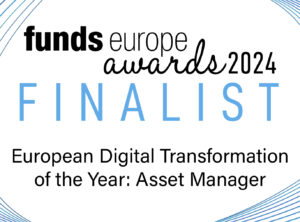
The Scaling of Large Language Models (LLMs) – Bigger, Smarter, and Specialized

#26 - Behind The Cloud: Beyond the Frontier - What’s Next for AI Systems in Asset Management? (1/8)
The Scaling of Large Language Models (LLMs) – Bigger, Smarter, and Specialized
November 2024
Beyond the Frontier – What’s Next for AI Systems in Asset Management?
This new series delves into the cutting-edge developments shaping the next era of Artificial Intelligence (AI). From advancements in foundational technologies to groundbreaking applications, each chapter will explore a transformative element of AI and its implications for the investment world. With asset management facing increasing complexity and competition, understanding these advancements is essential for staying ahead. Today we start with the first chapter …
The Scaling of Large Language Models – Bigger, Smarter, and Specialized
Large Language Models (LLMs) have rapidly evolved, becoming some of the most transformative tools in Artificial Intelligence (AI). From generating human-like text to assisting in complex decision-making, their capabilities are reshaping industries—including asset management. But what does the future hold for LLMs as they grow larger, smarter, and more specialized? In this chapter, we’ll explore the scaling of LLMs, the challenges that come with it, and their potential to revolutionize asset management.
The Growth Trajectory of LLMs
Scaling LLMs has been the cornerstone of their success. Models like GPT-4 and their successors have grown exponentially in size, leveraging billions of parameters to generate more nuanced, coherent, and context-aware outputs.
This scaling allows LLMs to:
- Understand and process complex queries with greater depth and precision.
- Generate text that closely mimics human thought and reasoning.
- Incorporate vast amounts of domain-specific knowledge.
For the asset management industry, these advancements mean better insights, faster analysis, and the ability to generate reports, research, and even strategies with minimal human intervention.
However, scaling LLMs comes with its own set of challenges. The computational requirements grow exponentially with the number of parameters, demanding vast amounts of energy, infrastructure, and financial investment. Furthermore, larger models can sometimes suffer from diminishing returns, where the performance gains do not justify the increased resource consumption.
Smarter Through Fine-Tuning and Training
While bigger models have demonstrated impressive capabilities, size alone does not equate to intelligence. The future of LLMs lies in smarter training processes, including:
- Fine-Tuning: By training LLMs on industry-specific data, they can become highly specialized tools for asset management. For example, a fine-tuned LLM could predict market trends, analyze portfolio risks, or even draft regulatory filings tailored to specific jurisdictions.
- Knowledge Retention: Advanced training techniques are helping LLMs retain knowledge while avoiding “catastrophic forgetting” when exposed to new data. This is especially useful in asset management, where models must adapt to dynamic markets while maintaining their understanding of long-term trends.
- Reinforcement Learning: Future LLMs may incorporate reinforcement learning to refine their decision-making processes, making them more adept at providing actionable investment recommendations.
Specialized Models: The Next Frontier
Rather than relying on a single, massive model, the trend is shifting towards smaller, specialized LLMs designed for specific tasks. In asset management, this could lead to models tailored for:
- Portfolio Management: Analyzing diverse portfolios to optimize allocations in real time.
- Risk Assessment: Predicting and mitigating risks based on historical and real-time data.
- Regulatory Compliance: Ensuring that investment strategies adhere to complex and evolving regulations worldwide.
- Client Communication: Generating highly personalized communication for investors, enhancing trust and transparency.
Specialized models not only deliver better performance in their respective domains but also reduce computational costs compared to a one-size-fits-all approach.
Challenges in Scaling LLMs for Asset Management
While the benefits are clear, scaling LLMs for asset management faces several obstacles:
- Data Sensitivity: Financial data is highly confidential, requiring robust privacy measures. Specialized LLMs must be trained on proprietary data without compromising security.
- Regulatory Scrutiny: The use of AI in finance is under increasing regulatory oversight. Firms must ensure their LLMs are explainable and compliant with industry standards.
- Cost Efficiency: Running large-scale LLMs is resource-intensive. Asset management firms will need to weigh the trade-offs between performance and cost-effectiveness, potentially relying on hybrid cloud infrastructure or smaller specialized models.
The Future Impact of Larger, Smarter, and Specialized LLMs
As LLMs scale, their impact on asset management will deepen. Here’s what the future might look like:
- Enhanced Decision-Making: With smarter and specialized LLMs, firms can make faster, data-driven decisions, responding dynamically to market changes.
- Streamlined Operations: Automation of repetitive tasks—like report generation, compliance checks, and client communication—will free up human talent for strategic initiatives.
- Democratized Expertise: By embedding specialized LLMs in tools accessible to smaller firms, advanced AI capabilities can level the playing field in the asset management industry.
However, there are critical considerations to keep in mind:
- Testing Challenges: LLMs possess vast amounts of knowledge, making it challenging to effectively test their outputs against unseen data. This difficulty arises because these models already “know” most historical data, which complicates the evaluation of their predictive accuracy in truly novel situations.
- Overfitting Risks: Due to their immense size and complexity, LLMs are particularly susceptible to overfitting, where the model performs well on training data but struggles to generalize to new, unseen data. Careful design of training pipelines and validation methods is essential to mitigate this risk and maintain their effectiveness.
Omphalos Fund: Scaling for Success
At Omphalos Fund, we are at the forefront of integrating LLM advancements into our operations. By leveraging both large-scale and specialized models, we are enhancing transparency, improving efficiency, and driving better investment outcomes for our clients.
We use LLMs as a supportive tool to analyze data and improve the efficiency of our quant and data science work. These models assist in uncovering insights from complex datasets, refining predictive models, and streamlining data-driven processes, allowing our teams to focus on higher-level strategic initiatives.
Our hybrid approach combines the analytical power of large models with the cost-efficiency and precision of smaller, task-specific models, ensuring that we remain agile in a fast-changing industry.
Conclusion: The Power of Scaling
The scaling of LLMs is redefining what AI can achieve in asset management. Bigger models bring unparalleled analytical capabilities, while smarter and specialized models ensure these tools remain relevant, efficient, and aligned with industry needs. At Omphalos Fund, we view these advancements not as a replacement for human expertise but as powerful tools that amplify it.
This concludes our first chapter in the series “𝗕𝗲𝘆𝗼𝗻𝗱 𝘁𝗵𝗲 𝗙𝗿𝗼𝗻𝘁𝗶𝗲𝗿: 𝗪𝗵𝗮𝘁’𝘀 𝗡𝗲𝘅𝘁 𝗳𝗼𝗿 𝗔𝗜 𝗦𝘆𝘀𝘁𝗲𝗺𝘀 𝗶𝗻 𝗔𝘀𝘀𝗲𝘁 𝗠𝗮𝗻𝗮𝗴𝗲𝗺𝗲𝗻𝘁?”
We hope it’s provided valuable insights into the cutting-edge developments shaping the next era of Artificial Intelligence (AI).
Next week in Behind the Cloud, we’ll dive into “Advanced Multi-Agent Systems – Coordinating Intelligence for Smarter Outcomes” and explore how coordinated AI systems can achieve what individual models cannot. Stay tuned!
If you missed our former editions of “Behind The Cloud”, please check out our BLOG.



